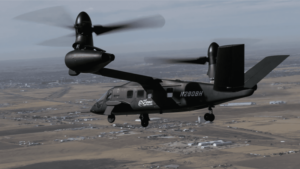After the Army locked in requirements over the summer, a Bell [TXT] official said the company’s work developing the service’s new Future Long Range Assault Aircraft (FLRAA) is heading toward a preliminary design review (PDR) in early 2024.
Paul Wilson, Bell’s program manager for FLRAA, told
Defense Daily on Wednesday the Army effort remains on track for a Milestone B decision in the third quarter of fiscal year 2024 to move into a program of record, setting up first flight in the “mid-2020’s” and first unit equipped in the early 2030’s.

“We’re still working toward the Army’s timeline for those objectives. I can’t get into the specifics of [flight test plans]. We’re still working toward a plan to execute that and get it into flight test as quickly as possible. I’ll say all these interim milestones are going according to plan,” Wilson said during an interview at the Association of the United States Army’s annual meeting in Washington, D.C.
Bell’s V-280 Valor tiltrotor aircraft was named the winner of the FLRAA competition on Dec. 5, beating out a Sikorsky [LMT] and Boeing [BA] team’s Defiant X coaxial rigid rotor helicopter offering for the program to find an eventual UH-60 Black Hawk helicopter replacement (Defense Daily, Dec. 5).
The Army’s initial FLRAA deal to Bell is worth up to $1.3 billion but could total $7 billion if all options are picked up.
Wilson noted the Army Requirements Oversight Council (AROC) met this summer to approve the capabilities development document for FLRAA, which essentially locks in the program’s requirements, while Bell has also completed its own system requirements and functions review.
“The AROC defines the high-level requirements, the overarching requirements, so, the capabilities that they’re looking for from the platform. And system requirements review is the next layer of detail, where those high-level capabilities are being composed into specific performance requirements for the platform. And that defines, then, what the team starts their design activities based on,” Wilson said.
Bell has been working on continued design activities ahead of the upcoming PDR, which will be followed by the Milestone B decision and a move into the Engineering, Manufacturing and Development (EMD) phase of FLRAA.
“In advance of that, we’re doing risk reduction activities to start detailed design and long-lead material activities, all in support to getting to the flight test vehicles for the program in EMD,” Wilson said.
Bell announced last month that GE Aerospace [GE] is developing the “Common Open Architecture Digital Backbone” for FLRAA, which is intended to support rapid integration of new capabilities on the platform (Defense Daily, Sept. 7).
“We identified GE as the partner of choice that can provide the network technologies to support Bell’s architecture,” Wilson said. “A key part of [FLRAA] has been Bell’s approach to the digital backbone and the overall architecture that supports the modular open systems approach. And with that architecture, it’s really designed to give the Army the ability to rapidly integrate new capabilities into the platform over the full lifecycle of the program and to be able to do so efficiently and affordably. That’s to make sure we’re always putting the latest technology that keeps up with emerging threats on the battlespace from a mission systems perspective.”
The Army in September released a Request for Information seeking industry input on potential mission equipment solutions for FLRAA, to include sensor systems, communication tools and pilot interfaces (Defense Daily, Sept. 8).